Resource
Structural Design of RCC Chute Spillways
Since 1980, engineers have utilized roller-compacted existing dams to increase the project discharge capacity. To date, over 40 earthfill embankment dams have been rehabilitated using RCC in the United States. RCC rehabilitation of existing embankment structures can be categorized into one of the following three design types:
Type 1: A mass RCC structure is placed directly downstream of the embankment as seen in Figure 1. The objective of this design is to allow limited erosion of an embankment down to a specific level to increase spillway capacity without losing the entire reservoir. Examples of this type of design include Boney Falls Dam (MI) and Nickajack Dam (TN).
Type 2: RCC is armored over the crest and downstream face of an existing embankment as shown in Figure 2. The objective of this design type is to allow the entire darn (or a large portion of it) to be overtopped while the RCC keeps the soil material from eroding. This type of structure usually requires low unit discharge, with overtopping heights in the range of 2 to 10 feet. Examples of this type of dam are Rosebud Dam (SD) and Brown County Country Club Dam (TX).
Type 3: RCC is used as a material for a large spillway - usually a service spillway or a combined service and emergency structure - as shown in Figure 3. The objective of this design type is to pass the entire project’s spillway discharge capacity requirement with one structure. This type of structure usually can accommodate large unit discharges with overtopping flow depths in the range of 10 to 20 feet. For the design of Type 1 structures, engineers usually follow established design methods for mass concrete dams, However, engineers have often used “rule of thumb” methods for the design of Type 2 and 3 spillway capacity expansions which were governed by conservative assumptions, construction equipment capabilities, and industry experience (“how everyone else was doing it “). For two recent rehabilitation projects, Harm engineers utilized RCC material for the construction of a combined service and emergency spillway - identified as Type 3 above. The structural design approach was more typical of a reinforced concrete chute spillway than a RCC structure. This paper documents the design approach and methodology as a guidance to other structural designers.
































